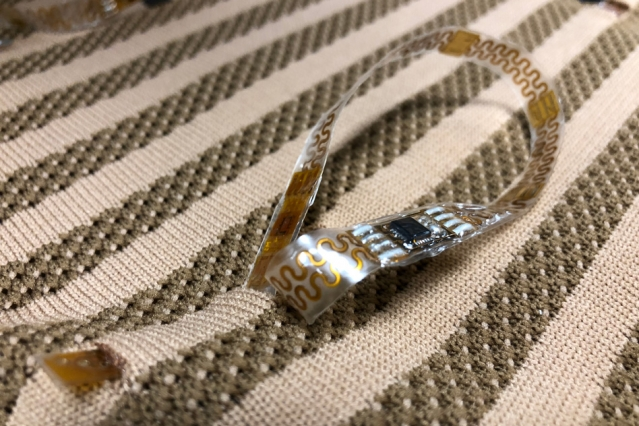Apr 24 2020
Scientists from the Massachusetts Institute of Technology (MIT) have come up with a new technique to integrate electronic sensors into stretchable fabrics, enabling them to design shirts or other kinds of garments that can potentially be used for tracking many vital signs like heart rate, respiration, and temperature.
 “We can have any commercially available electronic parts embedded within the textiles that we wear every day, creating conformable garments,” says Canan Dagdeviren, the LG Electronics Career Development Assistant Professor of Media Arts and Sciences at MIT. Image Credit: MIT.
“We can have any commercially available electronic parts embedded within the textiles that we wear every day, creating conformable garments,” says Canan Dagdeviren, the LG Electronics Career Development Assistant Professor of Media Arts and Sciences at MIT. Image Credit: MIT.
The garments embedded with these sensors can be washed in machines and can be tailored to fit snugly to the wearer’s body. According to the scientists, this kind of sensing can potentially be used for tracking sick patients, either in the hospital or at home, and could even be used for monitoring astronauts and athletes.
We can have any commercially available electronic parts or custom lab-made electronics embedded within the textiles that we wear every day, creating conformable garments. These are customizable, so we can make garments for anyone who needs to have some physical data from their body like temperature, respiration rate, and so forth.
Canan Dagdeviren, LG Electronics Career Development Assistant Professor of Media Arts and Sciences, MIT
Dagdeviren is the senior author of the study that described the novel material recently reported in the npg Flexible Electronics journal. Irmandy Wicaksono is a MIT graduate student and the study’s lead author. The study was also contributed by a number of MIT undergraduates via the Undergraduate Research Opportunities Program.
Embedded Sensors
Thin, skin-like patches have already been developed by other research teams and these are capable of measuring many vital signs, including temperature; however, these patches are fragile and have to be fixed to the skin.
Using a flexible fabric that can be integrated with removable electronic sensors, Dagdeviren’s Conformable Decoders team at the Media Lab embarked to produce garments that were almost the same as the clothes normally worn by people.
“In our case, the textile is not electrically functional. It’s just a passive element of our garment so that you can wear the devices comfortably and conformably during your daily activities,” added Dagdeviren. “Our main goal was to measure the physical activity of the body in terms of temperature, respiration, acceleration, all from the same body part, without requiring any fixture or any tape.”
The electronic sensors include lengthy and stretchable strips covered in epoxy and subsequently woven into constricted channels in the fabric. Miniscule openings in these narrow channels enable the electronic sensors to be exposed to the skin.
For this analysis, the scientists developed a shirt model that was embedded with 30 temperature sensors as well as a single accelerometer that can determine the breathing rate, heart rate, and movement of the person wearing it. This garment can subsequently transfer this information wirelessly to a smartphone.
For their study, the scientists selected a type of polyester blend, which has moisture-wicking characteristics and can blend with the skin, just like compression shirts worn by people during exercise.
Previous summer, a number of scientists spent time at Shenzhen, a China-based factory, to find out if this material can be produced at a larger scale to be utilized in the garments.
From the outside it looks like a normal T-shirt, but from the inside, you can see the electronic parts which are touching your skin. It compresses on your body, and the active parts of the sensors are exposed to the skin.
Canan Dagdeviren, LG Electronics Career Development Assistant Professor of Media Arts and Sciences, MIT
Even if the garments are integrated with sensors, they can still be washed and the sensors can also be detached and transferred to another garment.
Remote Monitoring
The scientists tested their prototype shirts while the wearers were exercising at the gym. This enabled them to track the changes in the wearers’ breathing rate, heart rate, and temperature. Since the sensors span a vast surface area of the body, the scientists were able to note the temperature fluctuations in various parts of the body, and the way those changes match with one another.
Dagdeviren informed that the prototype shirts can easily be produced in various sizes to fit people of varying ages and body types. She is now planning to create other kinds of garments, like pants, and is exploring the possibilities to integrate additional sensors for tracking blood oxygen levels and other health indicators.
According to Dagdeviren, this kind of sensing could prove handy for personalized telemedicine, enabling physicians to remotely monitor their patients from the comfort of their homes, or for tracking the health of astronauts during their space missions.
You don’t need to go to the doctor or do a video call. Through this kind of data collection, I think doctors can make better assessments and help their patients in a better way.
Canan Dagdeviren, LG Electronics Career Development Assistant Professor of Media Arts and Sciences, MIT
The study was financially supported by the MIT Media Lab Consortium and a NASA Translational Research Institute for Space Health Seed Grant from the MIT Media Lab Space Exploration Initiative.
Electronic Textile Conformable Suit (E-TeCS)
Video Credit: MIT.